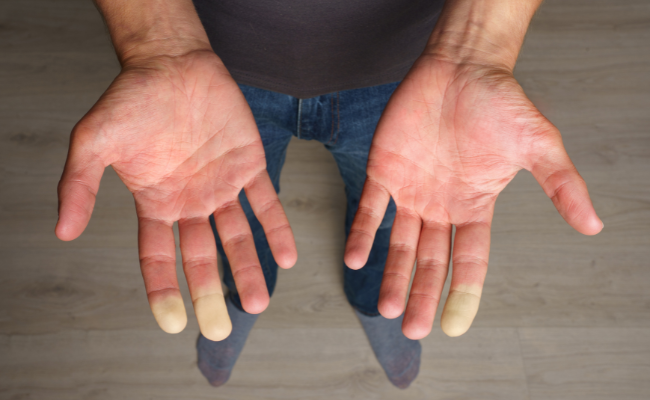How to Treat Raynauds?
- December 15, 2023
- No Comments

What is Raynaud's?
Raynaud's disease, also known as Raynaud's phenomenon or simply Raynaud's, is a vasospastic disorder that affects blood flow to certain parts of the body, most commonly the fingers and toes. The condition is characterized by episodic attacks called vasospasms, during which the blood vessels constrict excessively, leading to reduced blood flow. This constriction can result in temporary numbness, discoloration (usually turning white or blue), and, as blood flow returns, a reddish hue accompanied by a tingling sensation.
Why does Raynaud's Occur?
The exact cause of Raynaud's is not universally understood, and it can manifest in two primary forms: primary and secondary. Primary Raynaud's, also known as Raynaud's disease, occurs on its own and is generally less severe. Secondary Raynaud's, or Raynaud's phenomenon, is often associated with other autoimmune or connective tissue disorders like scleroderma, lupus, or rheumatoid arthritis.
The triggering factor for Raynaud's is often an exaggerated response to cold or stress, which induces vasospasms in susceptible individuals. Cold weather can lead to an abrupt narrowing of blood vessels, limiting blood supply to extremities. Emotional stress and, in some cases, the use of tobacco products can also act as triggers, exacerbating the condition.
How is Raynaud's Treated?
Managing Raynaud's involves a comprehensive approach that includes lifestyle modifications, medications, and, in severe cases, surgical interventions.
Lifestyle Changes:
- Avoiding Triggers: Identifying and steering clear of triggers is fundamental in managing Raynaud's. This includes staying warm in cold weather, using hand and foot warmers, and minimizing exposure to stressors.
- Dressing Warmly: Adequate clothing, especially during colder seasons, can significantly reduce the risk of vasospasms. Layering and thermal materials help in retaining body heat.
- Regular Exercise: Physical activity is beneficial for improving overall circulation. Engaging in regular exercise promotes cardiovascular health and reduces the frequency and severity of Raynaud's attacks.
Medications:
- Vasodilators: Medications that relax and widen blood vessels, such as calcium channel blockers (e.g., nifedipine) and nitroglycerin, may be prescribed to improve blood flow and prevent vasospasms.
- Prescription Medications: In certain cases, healthcare providers may recommend medications like sildenafil (commonly known as Viagra) to enhance blood flow.
Biofeedback and Relaxation Techniques:
- Biofeedback: This technique involves learning to control involuntary bodily functions, such as skin temperature, through monitoring devices. By gaining awareness and control over physiological processes, individuals can reduce the severity and frequency of Raynaud's attacks.
- Relaxation Techniques: Practices like meditation, deep breathing exercises, and yoga can help manage stress, a common trigger for Raynaud's episodes.
Treatment for Underlying Conditions:
- Managing Related Diseases: If Raynaud's is secondary to another condition, treating the underlying disease becomes crucial. This may involve a collaborative approach with specialists, such as rheumatologists or dermatologists, depending on the associated disorders.
Surgical Interventions:
- Sympathectomy: In severe cases resistant to other treatments, sympathectomy may be considered. This surgical procedure involves cutting or clamping the nerves that control blood vessel constriction.
Benefits of Treatment:
- Symptom Relief: Proper treatment significantly reduces the frequency and severity of Raynaud's attacks, providing relief from symptoms like numbness, discoloration, and discomfort.
- Improved Quality of Life: Implementing lifestyle changes and managing triggers allows individuals with Raynaud's to lead more comfortable and active lives. This includes participating in outdoor activities and social engagements without constant concern about triggering an episode.
- Prevention of Complications: Timely and effective treatment helps prevent complications associated with severe or prolonged Raynaud's. These complications can include digital ulcers, sores, and, in extreme cases, tissue damage.
- Enhanced Blood Circulation: Medications that promote vasodilation contribute to improved blood circulation. This not only reduces the risk of complications but also enhances overall vascular health, benefiting the entire circulatory system.
- Psychological Well-being: Biofeedback, relaxation techniques, and stress management strategies not only help in controlling Raynaud's symptoms but also contribute to better psychological well-being. Managing stress not only benefits Raynaud's but can have positive effects on overall mental health.
Comments (0)